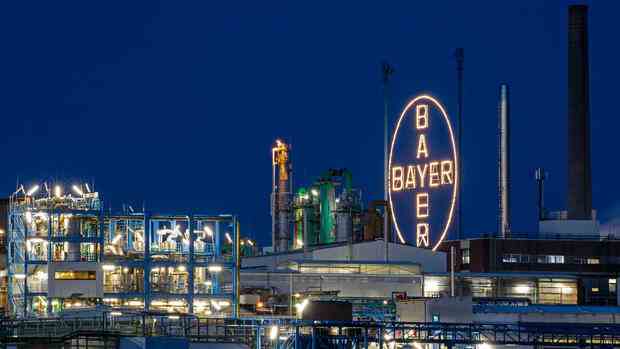Frankfurt Bayer believes its pharmaceuticals division will grow faster in the long term than previously assumed by many external observers. The Dax group has now almost doubled the sales forecast for its recently launched drugs and top development projects. Bayer is now anticipating peak sales totaling more than twelve billion euros.
Division head and board member Stefan Oelrich presented the corresponding figures on Tuesday at a healthcare conference of the investment bank JP Morgan in San Francisco. The Leverkusen-based group is thus demonstrating strong confidence that it will be able to cope better than feared with the approaching patent expiry of the previous top products Xarelto and Eylea.
The news was well received on the stock exchange. Bayer shares rose by 4.6 percent in the afternoon to EUR 54.20, putting them at the top of the Dax.
The growing self-confidence of the management is based on the successful market launch of the cancer drug Nubeqa and the kidney drug Kerendia, for which Bayer now sees sales potential of more than three billion euros.
Top jobs of the day
Find the best jobs now and
be notified by email.
On the other hand, the Dax group assumes that with the anticoagulant Asundexian, which is still in clinical development, it will be possible to introduce a successful successor product to the current bestseller Xarelto in a few years. For Asundexian, which has not yet been included in the group’s forecasts, the group calculates potential peak sales of more than five billion euros.
The successful launches of Nubeqa and Kerendia, as well as promising late-stage product candidates, reflected Bayer’s commitment to bringing innovative medicines to patients, said Oelrich. “The future sales growth potential will increase significantly over the next few years.”
In the medium term, additional sales in the billions could generate products from cell and gene therapy research, which Bayer has built up in recent years through various acquisitions and alliances. However, these projects are all still at an early stage of research.
For Asundexian, on the other hand, Bayer has now started a large phase 3 study to test the drug’s effectiveness and safety in a total of 30,000 patients. Oelrich sees Bayer as having a clear lead over its main competitor Bristol-Myers Squibb (BMS), which is also working on a factor XIa blocker.
Stronger focus on the US market
He assumes that if Asundexian is successful, the approval process could start in 2025 or 2026. The active ingredient, which blocks coagulation factor XIa, is intended to be used primarily for stroke prophylaxis, but is associated with a significantly lower risk of bleeding than previously established drugs such as Xarelto and Eliquis.
The group is also hoping for at least one billion euros in peak sales from the active ingredient elinzanetant, a potential drug for menopausal symptoms. Elinzanetant is also in pivotal Phase 3 clinical testing.
Bayer acquired this project in 2020 together with the British company Kandy. Bayer is also hoping for significantly positive effects from a higher-dose and therefore longer-acting version of the eye drug Eylea. It is expected that the effects of the patent expiry could at least be cushioned.
Oelrich considers the successful launch of the kidney drug Kerendia on the US market to be a particular success. Bayer has not previously been represented there with its own cardiovascular funds. Rather, the distribution of Xarelto had to be left to the US company Johnson & Johnson. According to Oelrich, Kerendia has been one of the strongest market launches to date in the USA.
In the future, Bayer intends to focus its business and research strategy more on the US market and market all products there itself. This should also significantly strengthen the long-term prospects for the division.
Just a period of weakness
For Oelrich and the Bayer management, the main aim of the new forecasts is to convince investors of the future potential of the Bayer pharmaceuticals division. Doubts about this are repeatedly fueled by the approaching patent expiry for the top products Xarelto and Eylea, which currently contribute around 40 percent to the division’s total sales of currently almost 20 billion euros.
Overall, Bayer’s research strategy has had only moderate success over the past decade. Of 50 clinical development projects that Oelrich found in the Bayer pipeline when he took over as the new head of the division at the end of 2018, 34 have since failed – including active ingredients against uterine adhesions, anemia, hemophilia, chronic cough and numerous oncology projects.
Virtually all Phase 2 projects turned out to be flops. And several new developments that achieved approval performed commercially, in some cases disappointingly, such as the cancer drug copanlisib.
>> Read also: German pharmaceutical giants are fighting to catch up
Oelrich admits that the division has a weak phase ahead of it. “The next three years will certainly not be a walk in the park for us,” he said. The patents on Xarelto have now expired in the first few countries, and more will follow in the next few years. In addition, the pressure on prices from health policy is increasing in what was previously the main market, Europe.
According to the Bayer manager, however, the reorganization of research that has taken place in recent years and the stronger focus on fundamental innovations will ensure stronger growth, especially in the second half of the decade.
With the reorientation of research, a long-term innovation system is being built up, which increasingly enables real breakthrough innovations, according to Oelrich. Bayer has invested a total of around seven billion euros in acquisitions and new alliances in the pharmaceutical sector in recent years.
The focus was on the takeover of the gene therapy specialist Ask Bio and the cell therapy company Blue Rock. Six products resulting from the new research platform are now in phase 1 clinical testing, including novel gene and cell therapies for Parkinson’s disease and heart failure.
More: After the Corona boom, the pharmaceutical industry is facing a dip in growth.

